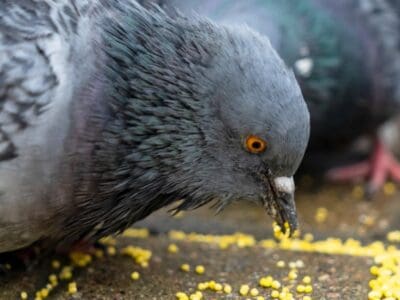Skunk
Also known as the Polecat!
Advertisement
Skunk Scientific Classification
Read our Complete Guide to Classification of Animals.
Skunk Conservation Status
Skunk Facts
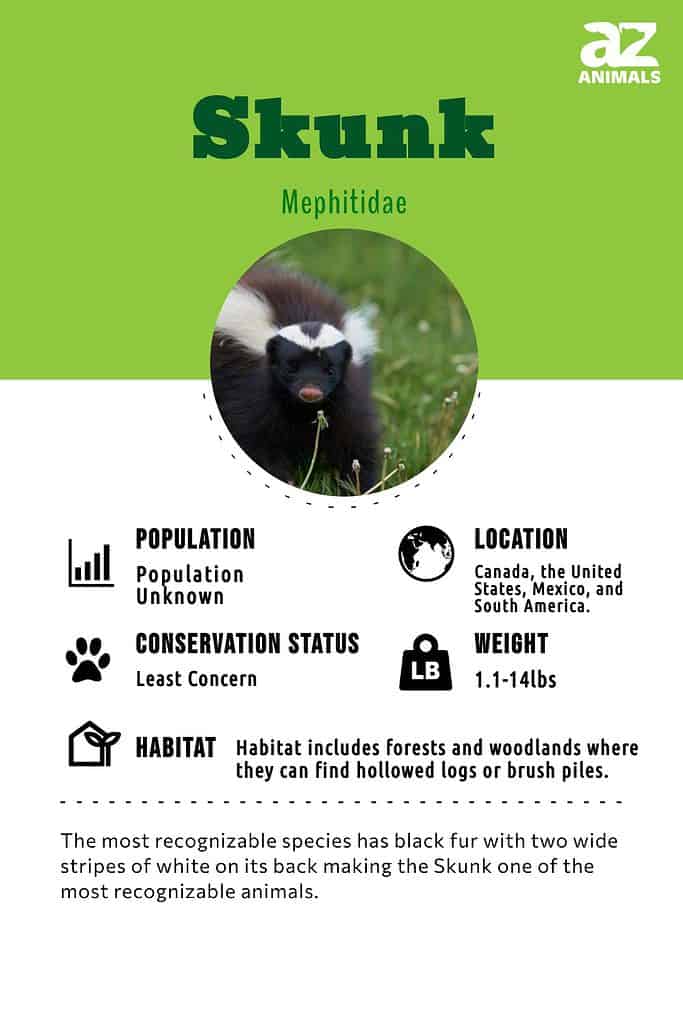
“A skunk’s spray can be detected at distances of up to 1.5 miles.”
Skunks are omnivores eating a diet of insects, fruit, fish, amphibians, reptiles, and small mammals. This animal is best known for its ability to spray an odorous (stinky) liquid from its scent glands. They use the spray as a defense against predators. Skunks live in Canada, the United States, Mexico, and South America. Female skunks give birth once a year.
5 Incredible Skunk Facts!
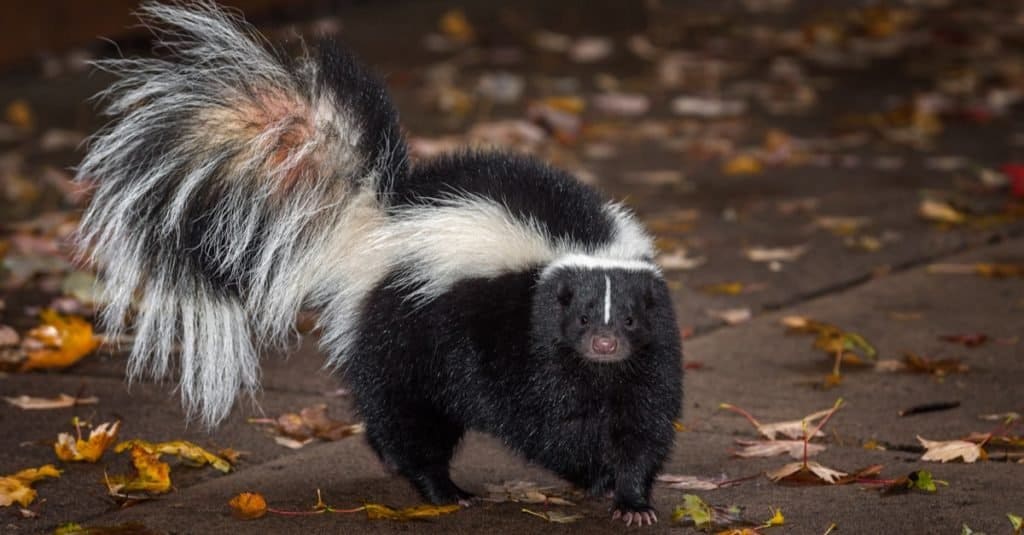
A female can have 2 to 10 babies in a litter
©Geoffrey Kuchera/Shutterstock.com
- These animals use their strong front legs and claws to dig for insects
- Skunks are not affected by snake venom
- They live in dens, hollow logs, burrows, and even abandoned barns and houses
- A female can have 2 to 10 babies in a litter
- Skunks are known to carry rabies and can pass it to other animals or even a family pet
You can check out more incredible facts about skunks.
Evolution and Origins
Skunks have been around for millions of years. In fact, the oldest fossil identified as a skunk dates back to about 11 or 12 million years ago and was discovered in what is now Germany. Data suggests that the skunk family came appeared about 30 to 40 million years ago.
Additionally, animals have a skunklike dentition dating back to the Late Cretaceous Epoch.
Scientific Name
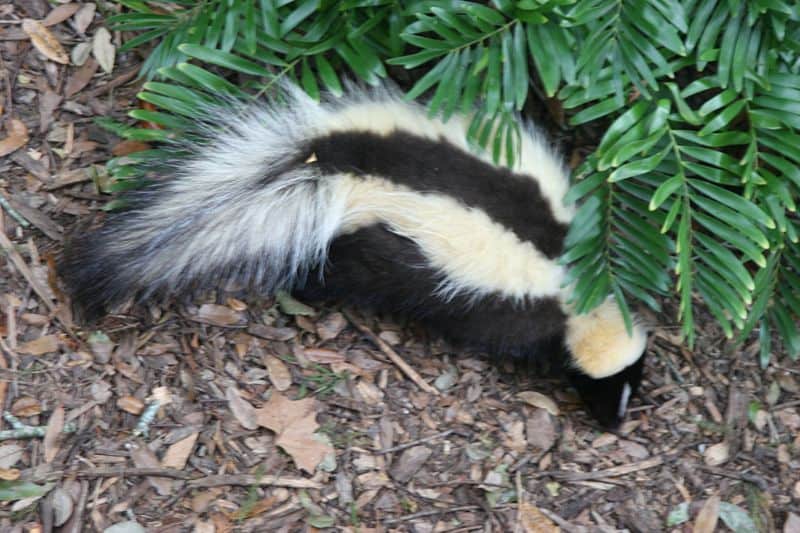
The scientific name for one of the skunk species is
Mephitis mephitis.
The scientific name for one of the skunk species is Mephitis mephitis. The Latin word mephitis means poisonous smell. This animal is sometimes called a polecat. At one time, they were mistaken for striped polecats (scientific name: Ictonyx striatus) due to their similar appearance.
These animals belong to the Mephitidae family and the class Mammalia.
The skunk family includes 12 species. Some of those include:
- Eastern spotted skunk
- Western spotted skunk
- Hog-nosed skunk
- Striped skunk
- Hooded skunk
- Mephitis
- Spotted skunks
- Molina’s hog-nosed skunk
- Stink badger
- Striped hog-nosed skunk
- Indonesian Stink Badger
- Palawan Stink Badger
Appearance and Behavior

The most recognizable species has black fur with two wide stripes of white on its back making the Skunk one of the most recognizable animals.
©Jeremy Richards/Shutterstock.com
The most recognizable species has black fur with two wide stripes of white on its back. Other species have swirls or spots of white on their black fur. An exception is an albino skunk. It has a coat of pure white fur. Albino skunks are rare.
They don’t have the ability to produce the melanin that darkens their fur. Albino skunks are different from animals with mostly white fur. One way to tell them apart is a white skunk has black eyes and an albino skunk has red eyes. Unfortunately, albino skunks usually have a short lifespan because they have other medical issues as a result of their rare genetics.
This animal’s traditional black and white coat makes it easily recognizable by humans. However, to its natural predators, the stark white stripe or spotted design of its coat is a visual signal to stay away. Don’t say I didn’t warn you!
These animals have four feet, tiny black eyes, and bristly tails with a mixture of black and white fur. Skunks have sharp teeth that help them to eat a variety of items in their diet. This animal has strong front feet with long claws that help them to dig burrows or look for worms and other insects. But you probably won’t see them digging a burrow.
They are known for taking up residence in burrows that have been abandoned by foxes, woodchucks, and other animals.
Some of these animals can use their claws to climb. The spotted skunk is able to use its strong feet and claws to climb trees. Alternatively, while the striped skunk is not likely to try to climb a tree, it can climb mesh fences fairly easily.
The animal’s body is from 8 to 19 inches long with a tail that can be as long as 15 inches. They can weigh from 6 to 14 pounds. Picture 9 golf tees lined up end to end and you’re looking at the length of a 19-inch skunk.
When it comes to weight, an average-sized skunk (about 10 pounds) weighs the same as a housecat. The American hog-nosed species is one of the longest measuring 2.7 feet from the tip of its nose to the end of its tail.
The most notable feature of this animal is its ability to spray. When this animal feels threatened, it releases a stinky liquid from scent glands beneath its tail. This liquid can travel up to 12 feet, so a predator doesn’t have to be close to a skunk to get sprayed!
Though this liquid isn’t poisonous, it takes several days for the smell to wear off an animal’s fur or body. Plus, if it gets into the eyes of an animal, it can sting. The predator runs off in an effort to get away from the powerful smell. That’s why this spray is so effective as a defense mechanism. Learn more about the stinkiest animals on earth here.
Skunks are mostly solitary animals. However, those that live in colder places may gather in groups of 10 to 20 inside burrows to keep warm.
A group of skunks is called a surfeit. Generally, they are shy creatures that try to stay out of sight. The only time these creatures show aggression is during breeding season when they are competing for mates. It is also important to know that skunks are not rodents.
Habitat
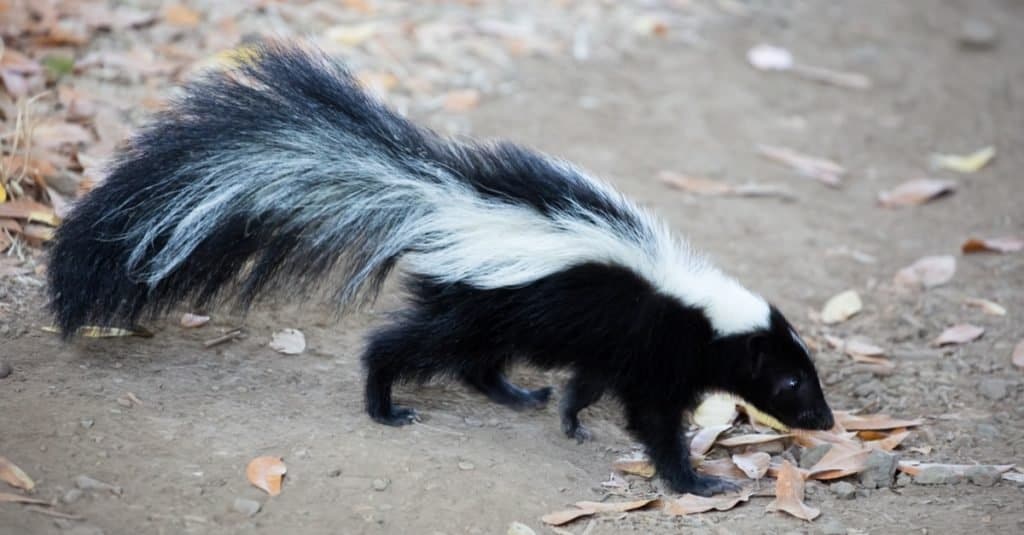
These animals live in Canada, the United States, Mexico, and South America.
©yhelfman/Shutterstock.com
These animals live in Canada, the United States, Mexico, and South America. They live in places with a temperate climate. Specifically, their habitat includes forests and woodlands where they can find hollowed logs or brush piles.
They sometimes live in burrows that have been abandoned by another animal. Most of them are found living within 2 miles of a stream or creek, so they have access to drinking water along with fish, frogs, and other types of prey.
During the cold-weather months, These animals stay in burrows to keep warm. Though they don’t officially hibernate, they sleep a lot during this season.
Furthermore, these animals don’t migrate. In fact, they live their lives within about a 2-mile range of their hollow log, den, or other shelters.
Diet
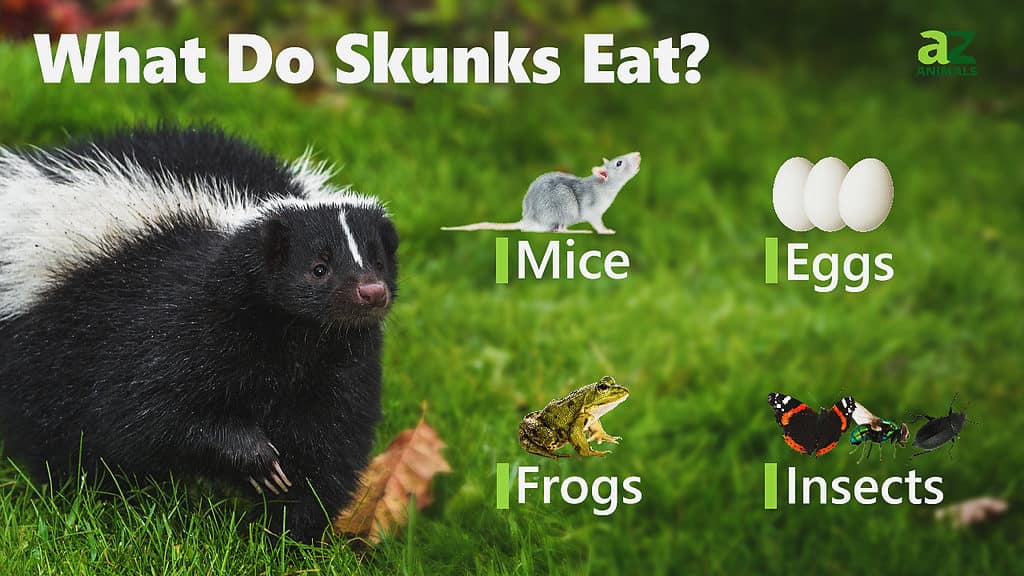
These animals are omnivores. Biologists consider them opportunistic feeders. This means they don’t have a specific list of things they eat. They’ll take the opportunity to eat anything available to them in their environment. For instance, if a skunk wanders into a neighborhood and finds a bird feeder, it will eat a seed that’s fallen on the ground.
What eats skunks?
The great horned owl is one of the main predators of these animals. Others include golden eagles, eagles, foxes, and coyotes.
What do skunks eat?
They eat fruit, plants, rodents, grasshoppers, worms, bird eggs, and frogs. They can also eat venomous snakes because they are immune to snake venom. These creatures eat whatever food source is most plentiful during the particular season.
Predators and Threats
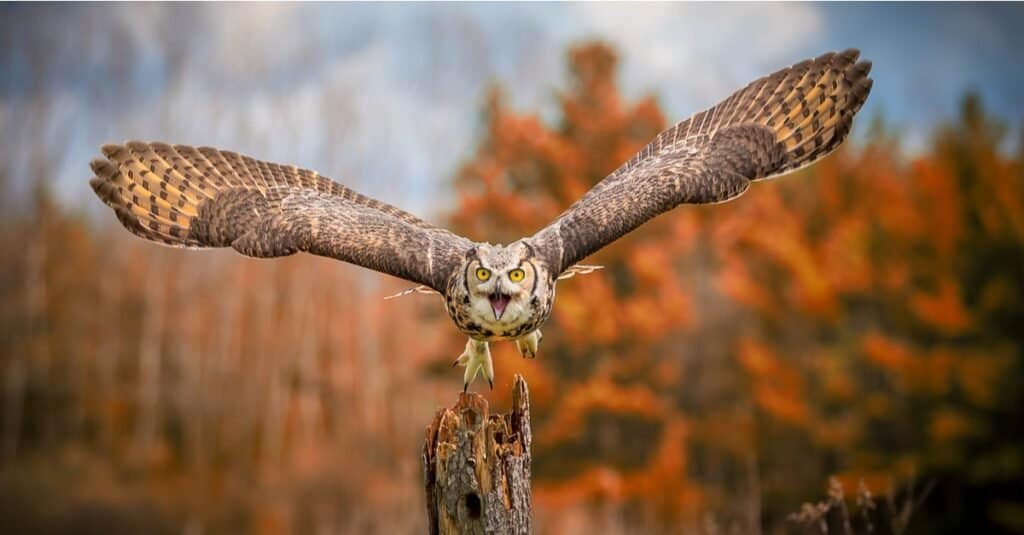
A flying Great Horned Owl prey on skunks.
©Imran Ashraf/Shutterstock.com
Because these animals are active at night, they are vulnerable to great horned owls. This owl can see the movement of a skunk in the dark. It can swoop down to capture it before the skunk is able to turn and release its repellent.
Other winged predators of these animals include bald eagles and golden eagles. Though coyotes and foxes are predators of the skunk, they are sometimes discouraged from approaching due to the skunk’s coloration and spray.
Drought is one environmental threat to skunks. Deforestation is another threat to the habitat of these animals. These animals are sometimes killed as pests in neighborhoods because they are known carriers of rabies. This disease can be passed on to a pet dog or cat. A human can also contract rabies from a skunk if the person is bitten or scratched. Of course, a person should go to the nearest hospital if bitten or scratched by a skunk.
As a note, these animals help to keep the population of insects and mice under control. In short, they serve a purpose in the ecosystem too!
The conservation status of the skunk is Least Concern with a stable population.
Reproduction, Babies, and Lifespan
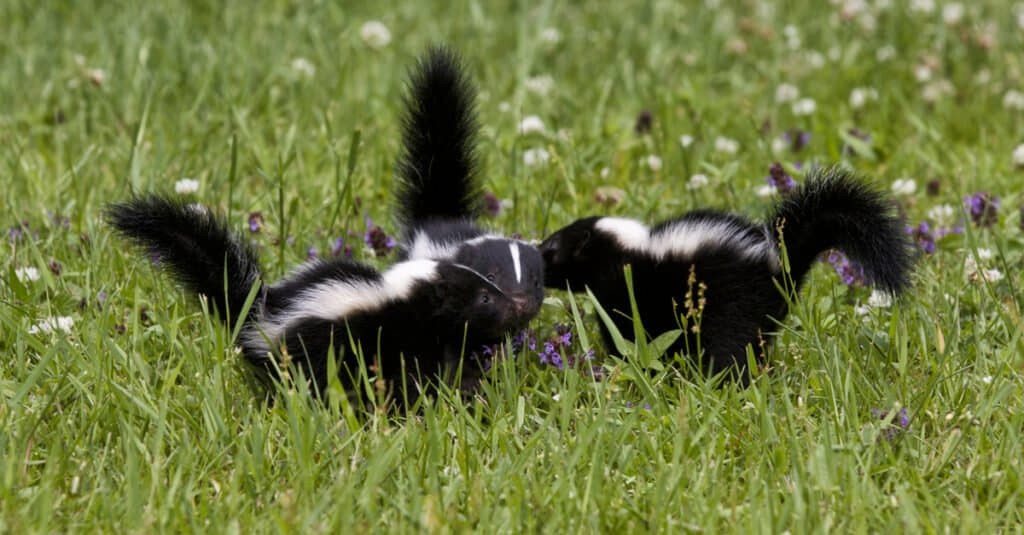
Skunks give birth to live babies in a den of grass.
©Debbie Steinhausser/Shutterstock.com
The breeding season of these animals is between February and April. A male looks for a female and wanders around her to see if she is ready to mate.
If the female wants nothing to do with the male, she releases her spray to chase him off. A male mates with several females in one breeding season. The gestation period of a female is 60 days. Females have just one litter per year.
The animal has live babies, aka kits, in a den filled with grass. A litter can contain from 2 to 10 kits. Each baby weighs around one ounce at birth and is not able to see or hear until it’s three weeks old. The female takes sole care of the kits and nurses them until they are six weeks old.
At that time, the female allows the kits to explore outside the den and they are weaned by the age of two months.
They become independent at around two months old and go off to look for their own shelter. Once a baby starts moving around outside of the den, it’s vulnerable to predators including owls, eagles, coyotes, and foxes. It’s not uncommon for kits to be killed before reaching one year old.
The lifespan of a skunk goes up to 7 years, but the average age is 3.
Population
The IUCN Red List of Threatened Species reports no specific population. But, because females have one litter of up to 10 kits per year, the population of this animal remains stable. The conservation status of the skunk is Least Concern.
Zoo
Can you visit these animals in the zoo? Yes, you can!
- Striped skunks are on display at the San Diego Zoo
- The western spotted skunk is on exhibit at the Sequoia Park Zoo
- See a gathering of striped skunks at the Elmwood Park Zoo
Skunk FAQs (Frequently Asked Questions)
Do Skunks make good pets?
First, the legality of skunks as pets varies significantly by region and country, so make sure keeping a pet is legal wherever you live. Second, skunks can serve as good pets if they’re captive-bred, but they’re a challenging pet that requires more time than most owners are willing to give.
Are Skunks herbivores, carnivores, or omnivores?
Skunks are omnivores. They eat whatever is most plentiful in their habitat.
What Kingdom do Skunks belong to?
Skunks belong to the Kingdom Animalia.
What class do Skunks belong to?
Skunks belong to the class Mammalia.
What phylum to Skunks belong to?
Skunks belong to the phylum Chordata.
What family do Skunks belong to?
Skunks belong to the family Mephitidae.
What order do Skunks belong to?
Skunks belong to the order Carnivora.
What type of covering do Skunks have?
Skunks are covered in fur.
What genus do Skunks belong to?
Skunks belong to the genus Mephitis.
In what type of habitat do Skunks live?
Skunks live in open woodlands and dense shrubs.
What do Skunks eat?
Skunks eat insects, rodents, and rabbits.
What are some predators of Skunks?
Predators of Skunks include owls, coyotes, and wild cats.
How many babies do Skunks have?
The average number of babies a Skunk has is 6.
What is an interesting fact about Skunks?
The Skunk is also known as the Polecat!
What is the scientific name for the Skunk?
The scientific name for the Skunk is Mephitis mephitis.
What is the lifespan of a Skunk?
Skunks can live for 5 to 8 years.
How fast is a Skunk?
A Skunk can travel at speeds of up to 10 miles per hour.
Are skunks dangerous?
No, skunks are not dangerous. However, if a skunk feels threatened or trapped in an area, it is likely to spray its repellent to defend itself. Or, if a person encounters a female skunk with a baby nearby, she may get very agitated if she feels her baby is in danger.
It’s legal to keep a skunk as a pet in 17 states. They can be affectionate and playful if raised with people. Most people who have a skunk as a pet have their scent glands removed.
How do you get a skunk to leave?
If you encounter a skunk in your yard or in the woods, back away from it slowly. This allows the skunk space to escape the area. They would rather run away than feel a level of danger that causes them to spray their repellent.
Why do skunks spray?
Skunks spray their repellent as a defense mechanism. They also spray to mark their territory.
How far can skunks spray?
The liquid from a skunk’s scent glands can travel up to 12 feet. The skunk turns, lifts its tail, and aims the repellent at whatever is threatening it.
This animal usually gives some warnings before it sprays. It may hiss or growl to try to discourage the threat from coming any closer.
How do you get rid of skunk odor?
Skunk odor is designed to stay on an animal’s fur for several days. Unfortunately, it’s common for a pet such as a dog to get sprayed while it is trying to chase a skunk out of its yard. There are now reliable cleaning solutions available that have ingredients that will get rid of the smell.
Some dog owners prefer a homemade solution. They combine one quart of 3% (or less) hydrogen peroxide solution with a quarter cup of baking soda and a teaspoon of dish soap. Using rubber gloves they wash their dog’s coat with this homemade solution, then rinse it thoroughly. You may need to repeat the process. Be sure to throw away any of the cleaning solutions that isn’t used.
You may have heard that tomato juice is great for washing the skunk smell out of a dog’s fur. However, tomato juice doesn’t go far in helping to get rid of the powerful odor.
What is the difference between a skunk and a badger?
One of the easiest ways to tell the difference between badgers and skunks is their size. Badgers are much larger than skunks, averaging between 24-30 lbs. The only time that a skunk and a badger would ever need to be identified by relative size is in North America since it’s the only range that both of them share. The largest species of badger is generally considered to be the European badger. The European badger is commonly used in cartoon descriptions and is often the one that most people are familiar with, although the American badger is a bit smaller and looks similar.
Who would win a fight between a raccoon and a skunk?
A showdown between a skunk and a raccoon would be evenly-matched, with both sides having a good chance. They both use a similar hunting technique that consists of a swift bite and the use of their extremely sharp claws when necessary, so there’s no chink in the armor of either in that department. Skunks have teeth that are slightly more suited to a fight, and their best defense is their spray. However, raccoons are slightly faster, have superior eyesight, particularly nimble hands, and more weight behind them – all of which would swing the fight in their favor. Despite this, the outcome of the fight could well come down to whether or not the raccoon can brave the pungent smell of the skunk long enough to overpower it.
Thank you for reading! Have some feedback for us? Contact the AZ Animals editorial team.
Sources
- Wikipedia, Available here: https://en.wikipedia.org/wiki/Skunk
- Chesapeake Bay Program, Available here: https://www.chesapeakebay.net/discover/field-guide/entry/striped_skunk
- Massachusetts, Available here: https://www.mass.gov/service-details/learn-about-skunks










